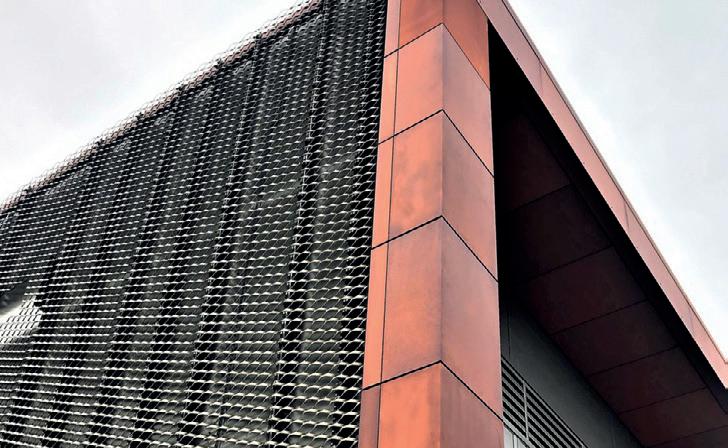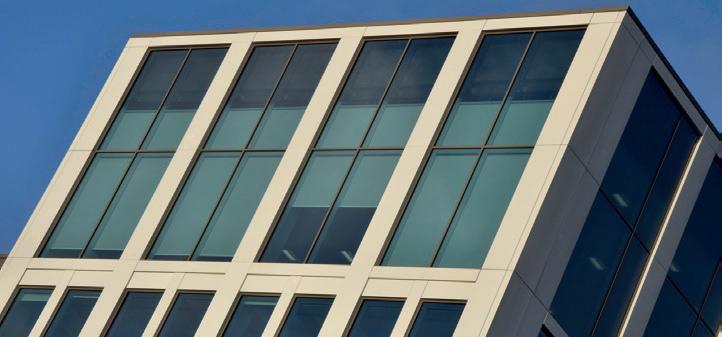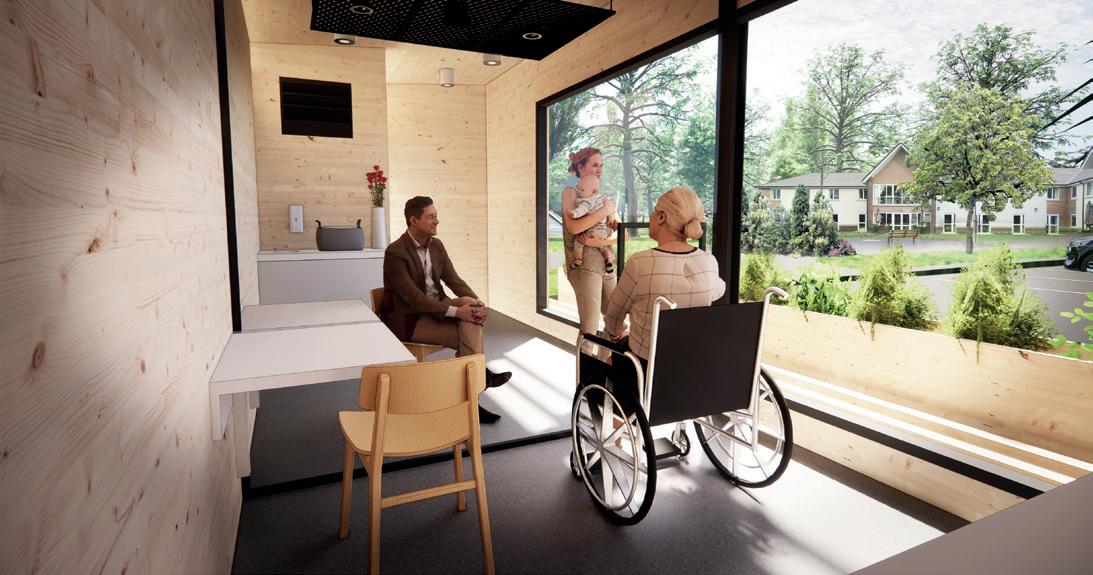
15 minute read
INDUSTRY UPDATES
THIS MONTH, FC&A HAS ASKED KEY PROFESSIONALS WITHIN THE ARCHITECTURAL AND CONSTRUCTION REALM TO VOICE THEIR VIEWS ON THE PRIME MINISTER’S ECONOMY SPEECH.
ALAN JONES, RIBA PRESIDENT:
Advertisement
“I welcome the recognition for ‘urgent action’ from the Prime Minister and hope the announcements are the first of many needed to address the shortcomings of the UK’s physical and social infrastructure. However, I am extremely concerned by the proposal to enable even more commercial buildings to change to residential use without the need for a planning application. The Government’s own advisory panel referred to the homes created by this policy as ‘slums’. It is hard to reconcile the commitment to quality with expanding a policy that has delivered low-quality, unsustainable and over-crowded homes across England. I urge the Prime Minister not to waste this opportunity and to re-build a more sustainable and resilient economy, ensuring that quality and safety remain at the heart of investment.”
C L A R E B O N D , PART II ARCHITECTURAL ASSISTANT AT SARAH WIGGLESWORTH ARCHITECTS:

“‘Build back better’ – it seems the Government now only communicates with us via the rule of three. The PM’s announcement begins with the need to regenerate existing buildings and this retro-first approach initially seemed to align with his ‘clean, green recovery’. That said, the proposed changes to the planning system promote regeneration at the cost of our small businesses (likely those hit during COVID-19) and high-street, rather than through improvements to current housing stock or getting tougher on sustainability requirements for new builds. Increased funding opportunities are much needed, but why does the Home Building Fund only apply to those creating new homes? As ever, more information please Boris!”
A L A S TA I R H A M I LTO N , PARTNER AT PICK EVERARD:

“The Government’s £5bn funding programme is welcome news, but fast and efficient delivery will be essential to its success. Quick, simple routes to market and access to skills and capacity are vital, and frameworks will play a key part here. The so-called ‘build back better’ agenda is also important. We mustn’t forget to drive the quality agenda at the same time to ensure we are building greener and more sustainably, achieving net-zero emissions, delivering on social value and biodiversity net gains while using the latest technologies to do that. The ‘Kickstart’ scheme will create jobs and help address the industry skills gap as we look to build our future, while investment in training throughout the supply chain will help support that legacy.”
G E R A R D TO P L A S S , EXECUTIVE CHAIRMAN OF FRAMEWORK PROVIDER PAGABO:

“It is in the Government’s interest to ensure that programmes plough ahead to meet previous targets and deliver on election promises to invest £250bn in the UK’s infrastructure. There were already ambitious targets prior to COVID-19, so ensuring that the path to recovery is a short one is absolutely crucial in achieving those promises, as well as delivering the necessary infrastructure projects that have come out of the pandemic, such as improving transport systems to allow for social distancing. At this time, being able to procure works quickly via a framework will help speed us along the road to recovery in construction, and we strongly believe that the quickest and most efficient way to procure is by using a framework agreement – particularly one with a designated Direct Award process.”
PAU L H U T T, D I R E C TO R AT G L A N C Y N I C H O L L S A RC H I T E C T S – A S P E C I A L I S T I N T H E D E S I G N O F D E M E N T I A A N D SOCIAL CARE DEVELOPMENTS:

“The pandemic has shone a light on the determination and caring nature of many individuals working in the care sector, but it has also highlighted flaws in the design of traditional care homes and their inherent inflexibility to adequately respond in terms of the physical environment and care and management strategies. The Prime Minister stated that we need to ‘build back better’ and that is certainly something we agree with. We are calling on the industry to promote an expansion, or an overhaul, of the national minimum standards for care home regulations to drive forward quality design. What will be crucial to this reform; however, is sustained investment and resourcing from central Government. The Prime Minister’s statement needs to be followed by adequate funding to allow these changes to happen.”
M I C H A E L C O N LO N , C H A I R M A N AT CONLON CONSTRUCTION:

“The Government has made a sensible step in prioritising construction as an area of investment to get the economy moving again. In the past, construction has contributed up to 10% of GDP and in terms of employment, it is powered by swathes of SMEs and family businesses who, as they return to work, will prove vital to our recovery. I thought the £1000 incentive from the Chancellor to bring employees back from furlough was a great idea and it will encourage even the smallest of businesses to welcome team members back into the fold. The plans to increase the number of apprenticeships will also ensure young people are empowered to learn new skills so they can begin contributing to the economy. We are particularly pleased to see investment in infrastructure as well as hospitals and schools; these areas have an immediate impact on the communities around them and suggest promise for the future. “
ARCHITECT IN PROFILE
This month, FC&A talks to Tean Chee Ko, Design Director of Hong Kong studio RMJM Red Studio, to find out more about his career, design ethos and upcoming projects.
RMJM RED STUDIO

TEAN CHEE KO

I M AG E S : 1: The China Construction Bank
headquarters in Ningbo
2: Alibaba’s headquarters
in Hangzhou
3: Shenzhen Bay Twin Towers Please tell us a bit about your career background. I trained in Australia and worked there for six years on residential, hospitality and commercial projects throughout Australia, Singapore, Malaysia and Thailand. Shortly after becoming a registered Architect, I moved to Shanghai with Australian firm Hassell. Significantly, we won the competition for Alibaba’s headquarters in Hangzhou. I then moved to Hong Kong and joined RMJM and have been here for the last 13 years. We have been running the RMJM Red Studio for almost seven years now with a focus on mixed-use projects in mainland China.
Had you always wanted to pursue a career in architecture? I hadn’t made up my mind about architecture as a career path until I had to make the formal decision. I was interested in a wide range of fields including graphic design, psychology, cartography, science and engineering. Sitting somewhat on the fence between the arts and science, architecture was a compelling direction.
In my second year at university, I remember being bemused by the structural engineer professor’s opinion of architects. He said that an architect was a “jack of all trades and master of none”. What he deemed to be a weakness of the discipline was for me its greatest draw.
Who has been your greatest influence and source of inspiration? Looking back, my father’s broad interests that ranged from the natural world to the arts and sciences shaped my holistic outlook on life and influenced my choice of career and how I live and work. For a conservative personality, he has a strong liberal mindset. Against the trend of the time and setting, he let me choose my career path independently.
Being part of the architectural fraternity and its way of life has been a big part of the story.
I’ve certainly been influenced by the well-known architectural firms and their work but what is most inspiring is seeing great work produced by lesserknown studios; there are too many to mention. They have such strength of faith to put everything on the line to push forward for what they believe in.
What has been your most notable project to date? It’s hard to pinpoint a single project, so I’ll grant myself three projects and justify each of them. The China Construction Bank headquarters in Ningbo was a bold proposal as a Brutalist piece of sculpture in a financial district filled with glass towers; it went against the grain. The Shenzhen Bay Twin Towers project was the first major win for the RMJM Red Studio and is about to complete construction. Having the towers inadvertently catch my eye kilometres away as I crossed the border from Hong Kong to Shenzhen was a surreal moment. The Alibaba headquarters in Hangzhou was my first project of such scale and significance, and it opened my eyes to the disruptive potential that architects have not only to the built environment but to the individual, to a corporate entity and everything around it.
All three of these projects are now built and as with all projects they are the result of concerted team effort. The fact that some projects become realised whilst others don’t is testament to the vision and endurance of each individual involved in these projects.
How do you approach your projects? We approach all projects from a blank page with as little preconception as possible. We spend a lot of time getting to know the site, the client and the brief. Then we engage

in discussion within the team and with stakeholders and start to imagine an appropriate response. The process may sound ordered and linear, but we’ve found that the strongest outcomes come from a more meandering path and so we let things happen more freely at the early stage. We will have dozens of schemes on the wall to ruminate over. These get refined, culled and short-listed until we have a single scheme that makes the most compelling argument. We enjoy the challenge of the competition process, but we prefer the dialogue of formulating a scheme in collaboration with the client.
When a scheme is determined, we work hard to navigate the myriad of factors and hurdles that come up during the process and focus on staying on target. We want to preserve the potency of the initial scheme and simply improve upon it, making it more polished.
What do you think is the greatest challenge for designing in sustainability? It’s always a challenge to convince a developer that the effort and capital investment put towards sustainability is worthwhile. Whilst most would agree with the long-term benefits of such initiatives; there are many other more immediate priorities that sideline sustainability. The greatest motivator in the decision-making is market opinion and what is deemed required and accepted in the market. Factors of speed and cost-effectiveness are still the most dominant drivers – hence the adoption of sustainable initiatives has not been strong.

China’s Green Building Standard, introduced in 2006, is a good system; however, it is voluntary, and there is little incentive to aim for the top three-star rating. I believe that making it mandatory for all residential and public projects over a certain size is possible, and by making it mandatory, we can bypass the slow uptake of green initiatives by the market.
What is your favourite building and why? I’ll avoid choosing an RMJM project to remove any bias. The Federation Square by Lab Architecture Studio in Melbourne is a truly civic project. I feel that it really represents the city’s textural and cultural richness. It’s a complex and ambitious project and is impactful to the way people interact with one another and the built environment. I could say the same of the DDP in Seoul by Zaha Hadid Architects. A completely different aesthetic but an equally impactful project.
What do you think is the greatest challenge for architects today? Time has always been a scarce resource for architects intent on crafting the best possible designs. Technology has paradoxically made those pressures even greater with the expectation that things can now be done faster.
For any practice, the challenge of overcoming financial and time pressures to deliver quality design is constant. “Good things take time”, but unfortunately, “time is money”. No doubt there have always been such constraints, but increased competitiveness in what is now a truly global marketplace has made the pressure seem more acute. What do you think is the greatest challenge for architecture students at the moment? It’s an issue that affects not just architecture students but practitioners as well. Instant access to vast amounts of design online can become an all too convenient ‘spice rack’ to find a style to mimic. It’s a double-edged sword that has allowed us to explore so much without leaving our chairs, but the understanding of the projects tends to be superficial, even graphical. I’ve seen what I believe to be the symptom of this practice in many new buildings. They’re photogenic, but when you’re there, moving through them and taking a closer look, it’s often disappointing.
It may be hard to conjure originality in this day and age, but there should be sincerity in the process in order to create something that is authentic and relevant.
What advice would you give to newly qualified architects? My suggestion to them would be to spend the initial years being as much of a generalist as possible. They should try to work on as many types of projects as possible, large/small, complex/simple, public/private. They could work on commercial, transport, residential, sports, hospitality, civic and educational projects. They should position themselves to be involved across all stages of the project, from project inception to concept design through to site supervision. There is a lot to learn, so I would suggest doing this for at least 10 years.
During this time, they should be figuring out what is of particular interest and to then start consciously specialising and becoming an expert in it. It could be theatre design, aged care facilities, facade design, high-rise towers or hotel resorts. The key is to be deliberate, always to be mindful of where you are in your career at any moment in time and where you want to be.
What can we expect to see from RMJM over the next year? RMJM’s strength is in its team’s diversity and open-minded approach to design. Each year, the projects delivered are of a wide variety and don’t conform to a particular style. So it’s always interesting to see what all the different studios have been working on.
RMJM Red Studio’s Shenzhen Bay Twin Towers will be completed in 2020, so it will be exciting to see it put into use. We have also been working on some unique mixeduse projects; from conceptual design to detailed design – several of which are under construction and will soon start to take shape. We have also been active on smaller-scale projects which have been a good counterbalance to our larger projects, each informing and enhancing the other.
Powdertech Terracotta

Powdertech Corby has launched three new powder coating collections, showcasing some of the most popular shades and textures in its wide repertoire.
POWDERTECH CORBY

Powdertech Rust

Powdertech Stone F inding the right shade for an external or internal architectural project is a rewarding part of a designer’s work but can be time-consuming and frankly quite overwhelming with the number of shades now available.
Helping to inspire
Powdertech wants to make the task easier for designers by curating together groups of colours and also by creating new unique finishes for emerging trends.
The three new collections are Stone, Rust and Terracotta, all earth-based shades reflecting the resurgence in popularity for designs based on natural materials. All the powders offer excellent metal protection, colour stability and are Qualicoat Class 1 and 2 approved.
Stone, rust and terracotta on metal
Stone shades used on metal mean that the solid and enduring appearance of stone can be achieved without the design constraints that the weight of the natural material imposes. Bespoke shades can be created to match or complement existing materials. Real stone needs a regular hard-hitting maintenance routine to maintain its fresh clean appearance, but these powder coatings need only a rinse over with water every six months or so in normal environmental conditions.
Powders in the Rust collection offer an industrial, lived-in look with excellent metal protection (despite the rusty appearance) and no run-off staining onto surrounding material. Many new developments on brownfield sites are drawn towards honouring the history of the site by referencing its past through colour and texture.
Warm and earthy, terracotta shades will never lose their appeal, and the powders in the Terracotta collection allow designers to combine the strength and versatility of aluminium and steel with the natural charm of terracotta, adaptable to Mediterranean, Eastern, rustic, industrial and even Art Deco styles.
Imagination given free rein
There really is no limit on the types of application and fabrication suitable for these finishes, excepting designers’ imaginations. Typical applications include facade cladding, solar shading, curtain wall, garden sculptures, perforated and expanded aluminium features, windows, trims, fittings, point of sale, retail display, signage; the list goes on. Any of these can be made to resemble stone, terracotta or weathered metal.












